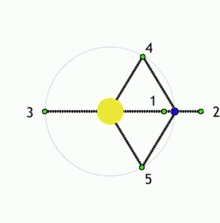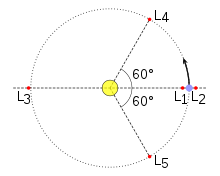Lagrange point
English

Lagrange points (green), primary central object (yellow) and secondary orbiting object (blue)
Alternative forms
- (astrophysics): Lagrangian point
Etymology

60-degree separation of L4 and L5 Lagrange points
Named after Joseph Louis Lagrange, who calculated points L4 and L5
Noun
Lagrange point (plural Lagrange points)
- (astrophysics) a point in an the orbital configuration of a two-body system where a small object affected only by gravity can theoretically be stationary relative to the two larger objects
- 2013 July 28, Megan Gannon, “Spacecraft Sees Giant 'Hole' In the Sun”, in news.yahoo.com, retrieved 2013-07-29:
- The $1.27-billion (1 billion euros) SOHO satellite was launched in 1995 and is flying a joint mission between NASA and the European Space Agency (ESA). It watches solar activity from an orbit about the Lagrange Point 1, a gravitationally stable spot between Earth and the sun that is about 932,000 miles (1.5 million kilometers) from our planet.
-
Translations
a point in an the orbital configuration
|
|
Synonyms
- (astrophysics): L-point
Hyponyms
- (astrophysics): Trojan point
Hypernyms
- (astrophysics): libration point
Derived terms
- (astrophysics): Lagrangian, Lagrangian asteroid, Lagrangian moon, Lagrangian planet
See also
- (astrophysics): barycenter
This article is issued from
Wiktionary.
The text is licensed under Creative
Commons - Attribution - Sharealike.
Additional terms may apply for the media files.